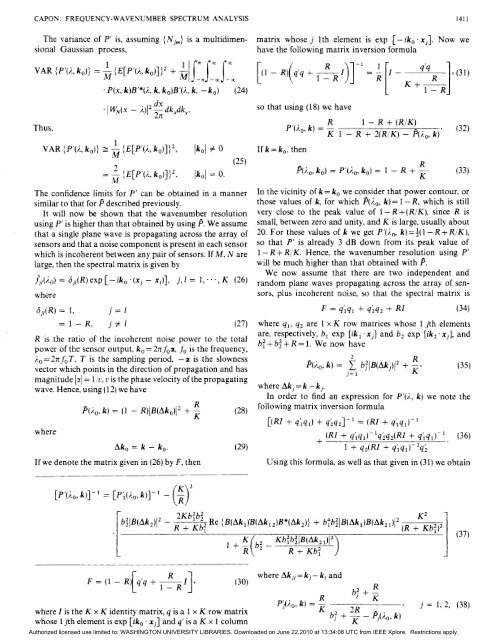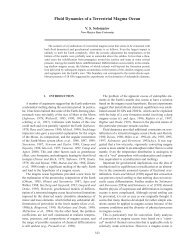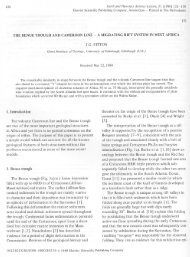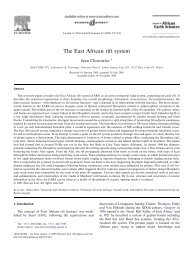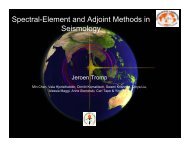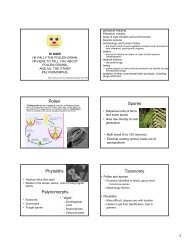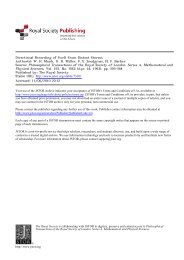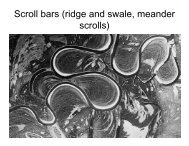High-Resolution Frequency-Wavenumber Spectrum Analysis
High-Resolution Frequency-Wavenumber Spectrum Analysis
High-Resolution Frequency-Wavenumber Spectrum Analysis
- No tags were found...
You also want an ePaper? Increase the reach of your titles
YUMPU automatically turns print PDFs into web optimized ePapers that Google loves.
CAPON: FREQUENCY-WAVENUMBER SPECTRUM ANALYSIS 1411The variance of P’ is, assuming (Njm} is a multidimensionalGaussian process,1VAR {P’().,ko)) = -(E[P’(i,ko)]}2+ -M. P(x, k)B’*(i, k, ko)B’()., k, - k,) (24)Thus,dx. I @$(X - ;.)I2 - dk,dk,.2n1VAR {P’(i., ko)} z - /E[P’(i, ko)]}’, lkol # 0ML-_ - (E[P’(E., k,)])’, lkol = 0..21(25)The confidence limits for P‘ can be obtained in a mannersimilar to that for ii described previously.It will now be shown that the wavenumber resolutionusing P’ is higher than that obtained by using P. We assumethat a single plane wave is propagating across the array ofsensors and that a noise component is present in each sensorwhich is incoherent between any pair of sensors. If M, N arelarge, then the spectral matrix is given by+&(E.,)where= 6,(R) exp [- ik, .(xj- x,)], j, 1 = 1, . . ., K (26)R is the ratio of the incoherent noisepower to the totalpower of the sensor output, k, = 2nf,a, fb is the frequency,E., = 2nf,T, T is the sampling period, -a is the slownessvector which points in the direction of propagation and hasmagnitude 1 x 1 = lk, c’ is the phase velocity of the propagatingwave. Hence, using (12) we havewhereP(Ebo,Rk) = (1- R)lB(Ako)12 + -K(28)matrix whose j lth element is exp [ -ik,. xj]. Now wehave the following matrix inversion formulaso that using (18) we haveIf k = k,, thenR 1 - R + (R/K)P’(j.0, k) = -K 1 - R + 2(R/K) - f‘(E.,, k) . (32)Rf‘(E.,, k,) = k,) = 1 - R + -.K(33)In the vicinity of k= k, we consider that power contour, orthose values of k, for which &20, k)= 1 - R, which is stillvery close to the peak value of 1 - R +(R/K), since R issmall, between zero and unity, and K is large, usually about20. For these values of k we get P‘(io, k)=gl- R + R/K),so that P‘ is already 3 dB down from its peak value of1 - R + R/K. Hence, the wavenumber resolution using P’will be much higher than that obtained with f‘.We now assume that there are two independent andrandom plane waves propagating across the array of sensors,plus incoherent noise, so that the spectral matrix is= d qi + 4;q2 + RI (34)where 41, 42 are 1 x K row matrices whose 1 jth elementsare, respectively, b, exp [ik, .xj] and b, exp [ik, .xj], andb: + b: + R = 1. We now have2k) = bjlB(Akj)I2 + -3j= 1 K&io,R(35)If we denote the matrix given in (26) by F, thenUsing this formula, as well as that given in (31) we obtain[P’(i,, k)]-’ = [P;(;.,,k)]-’ -(:yF = (1- R) q’q[+ ~1-R I].where I is the K x K identity matrix, q is a 1 x K row matrixwhose 1 jth element is exp [ik, . xj] and q‘ is a K x 1 columnwhere Akj, = kj - k, andRP;(E.,, k) = -KRb; + -K2RKbj + - - f‘j(i.0, k)j = 1,2, (38)Authorized licensed use limited to: WASHINGTON UNIVERSITY LIBRARIES. Downloaded on June 22,2010 at 13:34:08 UTC from IEEE Xplore. Restrictions apply.


